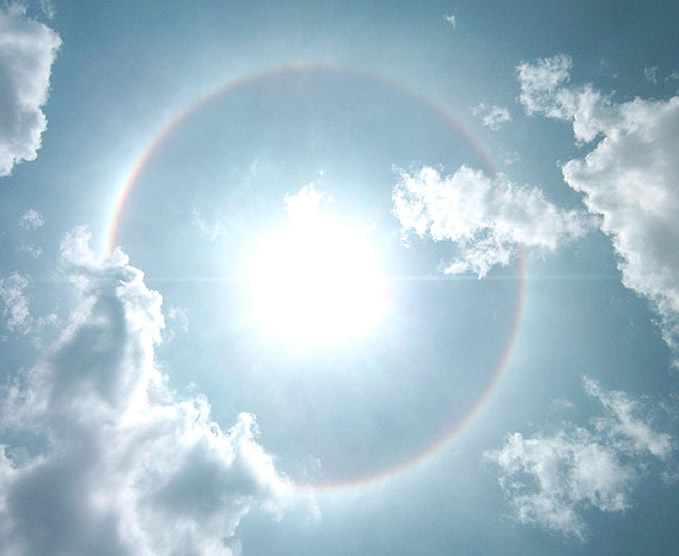
Image credit and copyright: David Hathaway/NASA/MSFC – www.spaceweather.com
Un alone (dal latino halōs “cerchio intorno al Sole”, a sua volta dal greco ἅλως hálōs) chiamato anche arco di ghiaccio, nimbo o aureola è un anello di luce che circonda un astro.
Gli aloni sono fenomeni ottici che appaiono vicini o attorno al Sole o alla Luna e a volte attorno ad altre forti sorgenti luminose come le luci stradali; l’alone stesso è di colore bianco intenso, con una sfumatura rossastra all’interno e violetta all’esterno; l’area di cielo interna all’alone è generalmente più scura si quella esterna. Gli aloni sono per la maggior parte causati da cristalli di ghiaccio nei freddi cirri ad altitudini di 5-10 km nella parte superiore della troposfera. La luce viene riflessa e rifratta dai cristalli di ghiaccio e potrebbe dividersi nei colori di base a causa della dispersione ottica, similmente agli arcobaleni. I due tipi fondamentali sono l’alone di 22° e l’alone di 46°. I vari tipi di alone sono dovuti alla forma particolare e all’orientamento dei cristalli di ghiaccio costituenti la nube.
Fonte/Leggi tutto → Wikipedia

A halo (from Greek ἅλως; also known as a nimbus, icebow or gloriole) is an optical phenomenon produced by ice crystals creating colored or white arcs and spots in the sky. Many are near the sun or moon but others are elsewhere and even in the opposite part of the sky. They can also form around artificial lights in very cold weather when ice crystals called diamond dust are floating in the nearby air.
Parhelia, or “Sun dogs” There are many types of ice halos. They are produced by the ice crystals in cirrus clouds high (5–10 km, or 3–6 miles) in the upper troposphere. The particular shape and orientation of the crystals is responsible for the type of halo observed. Light is reflected and refracted by the ice crystals and may split up into colors because of dispersion. The crystals behave like prisms and mirrors, refracting and reflecting sunlight between their faces, sending shafts of light in particular directions. Atmospheric phenomena such as halos were used as part of weather lore as an empirical means of weather forecasting before meteorology was developed. Other common optical phenomena involving water droplets rather than ice crystals include the glory and the rainbow.
Source/Continue reading → Wikipedia





















